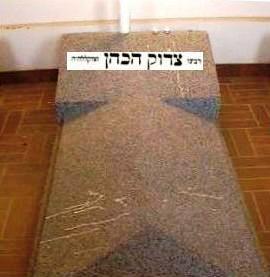This Day in History – 9 Elul/August 20
9 Elul
In 5027/1267, the Ramban arrived in Yerushalayim after being forced to flee his native Spain. He revived the Jewish community there soon after his arrival.
In 5698/1938, Jewish teachers and students were barred from all Italian schools.
Yahrtzeiten
5567/1807, Harav Yissochor, zt”l, the brother of the Vilna Gaon
5620/1860, Harav Shimon Zarchi, zt”l, author of She’eilos Uteshuvos Nachlas Shimon
5694/1934, Harav Aharon Menachem Mendel Gutterman, Rebbe of Radzimin, zy”a
5718/1958, Harav Yonasan Steif, zt”l, Rav of Budapest and Khal Adas Yereim, Brooklyn
5728/1968, Harav Yitzchak Friedman, Rebbe of Husyatin, zy”a
5736/1976, Harav Nachum Mordechai Perlow, Rebbe of Novominsk, zy”a

5660/1900
Harav Tzadok Hakohen Rabinowitz, Rebbe of Lublin, the Pri Tzaddik, Zy”a
Harav Tzadok Hakohen was born on 22 Shevat 5583/1823 to Harav Yaakov, zt”l, the Rav of Kreisburg, and Rebbetzin Yuta, a”h, a descendant of the Shelah Hakadosh.
From his earliest years, he studied Gemara intensely, at times under the light of the moon, since his parents could not afford candles.
At the age of 6, when his father was niftar, he moved into the home of his uncle, Harav Yosef, zt”l, author of Kapos Zahav.
He continued to excel and, at the age of 12, he was already writing she’eilos uteshuvos in halachah. At his bar mitzvah he delivered an intricate pilpul, astounding all the participants.
At 15, he became a son-in-law of a wealthy wine merchant, in whose home he continued to serve Hashem.
In 5600/1840, when he was but 17, he completed Shas, as he himself mentioned in a letter. He also published a number of sefarim,
Rav Tzadok became a devoted follower of the Izhbitzer Rebbe, zy”a. After his Rebbe’s petirah, Rav Tzadok accepted his close friend Harav Leibele Eiger, zy”a, of Lublin as Rebbe. During that period, Rav Tzadok secluded himself and devoted himself entirely to serving his Creator.
In 5648/1888, after the petirah of Rav Leibele, many Chassidim accepted Rav Tzadok as their Rebbe.
He eventually remarried a second and third time.
Rav Tzadok eschewed all worldly pleasures, conducting himself with extreme humility and kedushah. He would barely eat; in fact, he only ate at the daily siyum that he conducted. He did not accept any money from Chassidim except for monies given to him at a pidyon haben, which was rightfully his by Torah law since he was a Kohen.
Chassidim attested that during Shabbos he exuded an entirely different look, and that on Motzoei Shabbos he would literally have to be revived as he parted from his neshamah yeseirah.
He was niftar on 9 Elul and was buried in the ohel of his beloved Rebbe, Harav Yehuda Leib, zy”a, of Lublin. As he never had any children of his own, he asked his stepchildren to print his sefarim.
Among the myriad sefarim he authored are Pri Tzaddik, Tzidkas Hatzaddik, Resisei Layla, and Takanas Hashavin, Otzar Hamelech on Rambam, Meishiv Hata’ana on ibur hashanah, and Sefer Hazichronos, which he wrote in his youth. Many of his manuscripts were unpublished.
Zechuso yagen aleinu.
August 20
In 1914, German forces occupied Brussels, Belgium, during World War I.
In 1940, during World War II, British Prime Minister Winston Churchill paid tribute to the Royal Air Force before the House of Commons, saying, “Never in the field of human conflict was so much owed by so many to so few.”
In 1964, President Lyndon B. Johnson signed the Economic Opportunity Act, a nearly $1 billion anti-poverty measure.
In 1968, the Soviet Union and other Warsaw Pact nations began invading Czechoslovakia to crush the “Prague Spring” liberalization drive.
In 1977, the U.S. launched Voyager II, an unmanned spacecraft carrying a 12-inch copper phonograph record containing greetings in dozens of languages, samples of music and sounds of nature.
To Read The Full Story
Are you already a subscriber?
Click "Sign In" to log in!

Become a Web Subscriber
Click “Subscribe” below to begin the process of becoming a new subscriber.

Become a Print + Web Subscriber
Click “Subscribe” below to begin the process of becoming a new subscriber.

Renew Print + Web Subscription
Click “Renew Subscription” below to begin the process of renewing your subscription.



